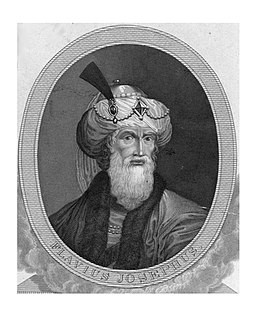UCL Early Modern Judaica to form Module of Early European Books (“EEB”) Online
By Tabitha Tuckett, on 3 May 2023
This post was written by Caroline Kimbell, Joint Head Of Commercial Digitisation And Licensing at UCL Library Services
Following the digitisation of UCL’s 18th century treasures (currently in production) we turn next to a new module for ProQuest’s Early European Books, comprising 515 works of Judaica, roughly half in Hebrew, half in other European languages.
UCL’s Jewish collections are of national significance, and the majority of this project is drawn from the Mocatta collection. Books and pamphlets published before 1700 are in scope, and include 10 Incunabula, the oldest from 1470. EEB to date only includes 164 Hebrew books, but aspires to provide a comprehensive Jewish history resource.

Portrait of Joesphus Flavius. Artist unknown (18th Century). https://www.bildarchivaustria.at/Pages/ImageDetail.aspx?p_iBildID=7956120
Our contribution includes works in 10 languages besides Hebrew, including Catalan, German, Aramaic, Italian and Greek alongside English. The places of publication represented reflect early modern Jewish Europe, with major centres in Amsterdam, Venice, Antwerp, Prague, Krakow, Berlin, Geneva, Salonika and Istanbul. The module is heavy on hefty, high-status books, many bearing elaborate metal clasps and fine bindings. There is, inevitably, an emphasis on religious texts – Torahs, Psalms and lamentations, prayers, religious and ritual works, theological commentary and Jewish history. 50 works by first century Roman-Jewish historian Flavius Josephus are included, and the module will therefore represent early modern Judaism from the inside.
However, inevitably, much of the collection represents the Christian world’s responses to Judaism. From 1656 we find “A view of the Jewish religion: containing the manner of life, rites, ceremonies and customes of the Jewish nation throughout the World at this present time”, a French “Histoire des Tvrks et d’un Juif; avec discovrs de l’entier banissment des Juifs du Royaume” and an account from 1655 of “a great council of Jews assembled in the plain of Ageda in Hungaria”. There is widespread fascination with Jewish daily life – one account from 1656 promises to describe “their doings at night when they come home”.
In 17th century London, as today, sensational language drove book sales – epitomised in one title – “wonderful and deplorable”. In this vein, we find “the Counterfiet Jew” assuring readers that “It would fill to much paper to describe all the lyes, forgeries, hypocrisies and slights of this miserable wretch”. There are many individual conversion narratives – most famously those of Eve Cohan and Theodore John, the latter baptised at the German Lutheran church in Little Trinity Lane – just one sign that London has always been a Global City. Pamphleteers skirmish back and forth on the subjects of naturalisation, conversion and protestant conformity: one Mocatta pamphlet from 1693 recounts an atheist “apostized from the Christian religion [who] died in despair”.
Writers and readers were also fascinated by cabalistic practice, Jewish medicine, magic and folklore. In MOCATTA 1666 L4 we find an account of “how the Persians were strucken with blindness, when they attempted to rifle the houses of the Jews and spoyle their goods”. In 1653, we find Robert Filmer explaining “the difference between an English and Hebrew vvitch” (always handy to know) and from Cornwall, the story of “Ann Jeffries… who was fed for six months by a small sort of airy people called fairies”.

Interior of a synagogue. By a follower of Gerrit de Wet (1616-74). National Museum in Warsaw ID: 505633
English travel narratives from Europe and the near East tend decidedly to the picaresque – from 1699 we find “Two journeys to Jerusalem. : Containing… a strange and true account of the travels of two English pilgrims… and what admirable accidents befel them in their journey to Jerusalem, Cairo, Alexandria… beautified with pictures.” Other descriptions cover the Caucasus, the Tartar mountains, Morocco (“The present state of the Jews… in Barbary”) and recount the miraculous raising of the dead by Nathan the Prophet, earnestly evidenced as “the true copy of a letter sent to the East-India Company”. More sober accounts of the pan-European world of trade and business include, at MOCATTA 1678 M1, letters between merchants in London and Amsterdam.
Evidencing everyday co-existence and mutual curiosity, many books here navigate between languages and cultures – there are bi-lingual dictionaries and Henry Care’s invaluable “The Jewish calendar explained” from 1673. Many of the works here use the Jewish calendar: 316 equates to 1556, 448 to 1688 for example. Date formats and the right-to-left pagination of Hebrew books pose particular challenges for digitisation and on-screen navigation, but contributing a dedicated Judaica module to such a reputable, international online resource as EEB will enhance UCL’s global reputation for Jewish studies. UCL library users already enjoy access to EEB, and the collection will be available from launch in 2024. For more information on the Mocatta collection, which supplies the majority of content for this project, see the Hebrew and Jewish Rare Books webpage.
 Close
Close


